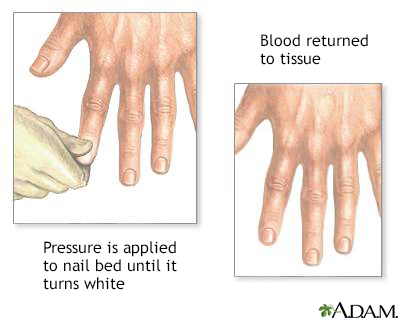Capillary nail refill test
Definition
The capillary nail refill test is a quick test done on the nail beds. It is used to monitor dehydration and the amount of blood flow to tissue.
Alternative Names
Nail blanch test; Capillary refill time
How the Test is Performed
Pressure is applied to the nail bed until it turns white. This indicates that the blood has been forced from the tissue under the nail. It is called blanching. Once the tissue has blanched, pressure is removed.
While the person holds their hand above their heart, the health care provider measures the time it takes for blood to return to the tissue. Return of blood is indicated by the nail turning back to a pink color.
How to Prepare for the Test
Remove colored nail polish before this test.
How the Test will Feel
There will be minor pressure to the bed of your nail. This should not cause discomfort.
Why the Test is Performed
Tissues need oxygen to survive. Oxygen is carried to various parts of the body by the blood (vascular) system.
This test measures how well the vascular system works in your hands and feet -- the parts of your body that are farthest from the heart.
Normal Results
If there is good blood flow to the nail bed, a pink color should return in less than 2 seconds after pressure is removed.
What Abnormal Results Mean
Blanch times that are greater than 2 seconds may indicate:
- Dehydration
- Hypothermia
- Low blood pressure
- Peripheral vascular disease (PVD)
- Shock
Gallery

References
McGrath JL, Bachmann DJ. Vital signs measurement. In: Roberts JR, Custalow CB, Thomsen TW, eds. Roberts and Hedges' Clinical Procedures in Emergency Medicine and Acute Care. 7th ed. Philadelphia, PA: Elsevier; 2019:chap 1.
Stearns DA, Peak DA. Hand. In: Walls RM, Hockberger RS, Gausche-Hill M, eds. Rosen's Emergency Medicine: Concepts and Clinical Practice. 9th ed. Philadelphia, PA: Elsevier; 2018:chap 43.
Swartz MH. The peripheral vascular system. In: Swartz MH, ed. Textbook of Physical Diagnosis: History and Examination. 8th ed. Philadelphia, PA: Elsevier; 2021:chap 15.